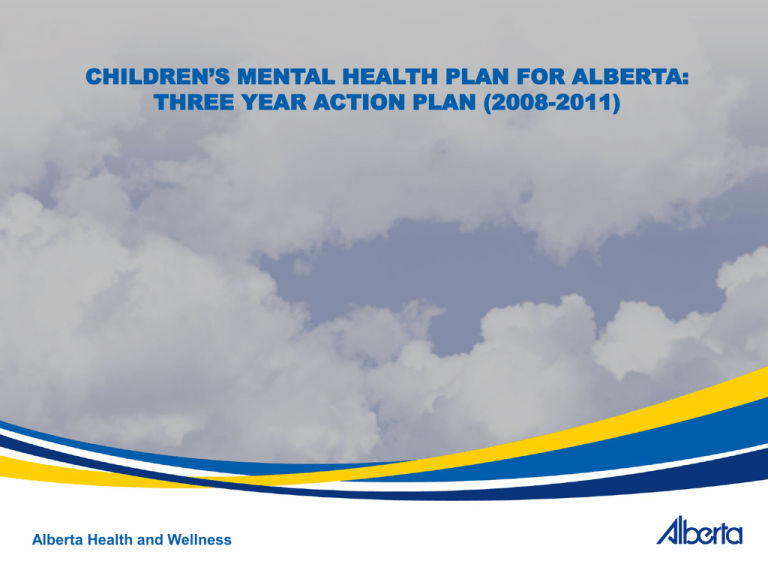Children's Mental Health Plan for Alberta: Three Year Action Plan
advertisement

CHILDREN’S MENTAL HEALTH PLAN FOR ALBERTA: THREE YEAR ACTION PLAN (2008-2011) Alberta Health and Wellness CHILDREN’S MENTAL HEALTH PLAN FOR ALBERTA: THREE YEAR ACTION PLAN (2008-2011) • September, 2006: Release of Positive Futures – Optimizing Mental Health for Alberta’s Children and Youth: A Framework for Action (2006-2016) 3 Strategic Directions $38.9 invested in Alberta Health and Wellness children’s mental health promotion and prevention projects, including building mental health capacity in schools 2 CHILDREN’S MENTAL HEALTH PLAN FOR ALBERTA: THREE YEAR ACTION PLAN (2008-2011) The Children’s Mental Health Plan for Alberta: Three Year Action Plan (2008-2011) was announced on August 29, 2008. • 3 year action plan to improve access to mental health services for children, youth and their families; and to address the needs of children and youth at risk. • Informed by Positive Futures and the implementation planning that occurred over the past two years with 9 ministries, AADAC, the AMHB and regional health authorities. • Includes an investment of $50.5 million in 6 strategies with 23 actions. 3 CHILDREN’S MENTAL HEALTH PLAN FOR ALBERTA: THREE YEAR ACTION PLAN (2008-2011) Safe Communities Enhanced access to school addictions counselors Addiction Prevention in Schools Treatment for Perpetrators of Family Violence Protection of Children Abusing Drugs enhancement Increased treatment beds for young adults with addictions 4 Cross-ministry Initiatives Student Health Children and Youth with Complex Needs Prevention of Family Violence and Bullying FASD Strategy Alberta Mentoring Partnership (Leadership Team) Strategy Aboriginal Youth Suicide Prevention Strategy Building Mental Health Capacity in Schools (wellness, resiliency and mental health promotion) CHILDREN’S MENTAL HEALTH PLAN FOR ALBERTA: THREE YEAR ACTION PLAN (2008-2011) GOAL 1: ACCESS Improve equitable access to the full range of children’s mental health services across the province and decrease children’s mental health wait-times for services. This will be achieved by building local capacity and implementing innovative strategies that serve infants, children, youth and their families in their own communities where they live, learn and play. GOAL 2: CHILDREN AND YOUTH AT RISK Improve access to effective and innovative services across the mental health continuum through innovative partnerships between health areas, schools and community agencies. This includes prevention, early intervention, treatment and supports that address the needs of children and youth at risk, including the needs of Aboriginal and immigrant/refugee children and youth. 5 CHILDREN’S MENTAL HEALTH PLAN FOR ALBERTA: THREE YEAR ACTION PLAN (2008-2011) GOAL 1: ACCESS STRATEGY 1 Implement coordinated access standards for children’s mental health services for emergent care (within 24 hrs.), urgent care (within 2 weeks) and scheduled visits (within 30 days). Western Canada Waiting List Children’s Mental Health Services 1. Prioritization Tool 2. Mental health workers in urban ERs and crisis triage therapists in rural areas 3. Urgent bookable clinics within 2 weeks (walk-in/single session) 4. Coordinated regional intake processes 5. Children’s mental health in primary care networks 6 CHILDREN’S MENTAL HEALTH PLAN FOR ALBERTA: THREE YEAR ACTION PLAN (2008-2011) GOAL 1: ACCESS STRATEGY 2 Increase access to basic and specialized children’s mental health services for those children and youth who reside in rural and remote areas across the province. 6. Community geographic teams 7. Clinical consultation and education for rural and remote areas 8. Mental health treatment beds for children and youth from northern Alberta 9. Assess the need for community-based mental health treatment group homes in rural areas 7 CHILDREN’S MENTAL HEALTH PLAN FOR ALBERTA: THREE YEAR ACTION PLAN (2008-2011) GOAL 1: ACCESS STRATEGY 3 Enhance and strengthen collaboration and coordination of services for children and youth during transition from psychiatric inpatient care to the community, including family and school support. 10. 11. Community extension teams Follow-up protocols between health, CFSAs, DFNAs, schools and other community agencies 12. Transitional Youth Services 8 CHILDREN’S MENTAL HEALTH PLAN FOR ALBERTA: THREE YEAR ACTION PLAN (2008-2011) GOAL 2: CHILDREN AND YOUTH AT RISK STRATEGY 1 Increase the number of innovative mental health service delivery practices/models in schools that address the needs of children and youth at risk, using collaborative partnerships and joint decision-making between health services and schools. 13. Mental health service models in schools 14. Centralized learning treatment classrooms 15. Mental Health First Aid for teachers 16. Peer Support models in schools 9 CHILDREN’S MENTAL HEALTH PLAN FOR ALBERTA: THREE YEAR ACTION PLAN (2008-2011) GOAL 2: CHILDREN AND YOUTH AT RISK STRATEGY 2 Reduce risk factors associated with poor mental health in populations at risk through innovative targeted strategies in children’s mental health. 17. Post-traumatic stress disorder treatment service for immigrants and refugee children and their families 18. Home visitation services for vulnerable families 19. Mental health consultation on pediatric medical units 10 CHILDREN’S MENTAL HEALTH PLAN FOR ALBERTA: THREE YEAR ACTION PLAN (2008-2011) GOAL 2: CHILDREN AND YOUTH AT RISK STRATEGY 3 Enhance and build upon infant and preschool development screening and mental health intervention programs to provide early intervention to families and young children at risk for developing mental health problems. 20. Pre-school developmental screening and intervention programs (ASQ-SE) 21. E/B child development tools 22. 3 pilot projects – prenatal and at-birth screening and intervention programs 23. 1 pilot project – pre-school assessment and intervention clinic for infants and young children who have experienced trauma 11 CHILDREN’S MENTAL HEALTH PLAN FOR ALBERTA: THREE YEAR ACTION PLAN (2008-2011) Final Comments • There continue to be significant mental health workforce issues (e.g., shortages of psychiatrists, child psychiatrists, therapists). Mental health workforce issues have been integrated into the Comprehensive Health Workforce Action Plan as part of a policy/ governance decision to integrate mental health into the broader system. • The $50.5 has been granted to Alberta Health Services to implement the 23 actions in the Plan over the next three years. 12




